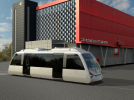Steddenm
Member
I have heard that the new Coventry Very Light Rail has been awarded to Rail Adventure to operate the short trial run in the city.

According to Coventry City Council the service will operate in May and June of this year.

 www.coventry.gov.uk
www.coventry.gov.uk

According to Coventry City Council the service will operate in May and June of this year.

Coventry Very Light Rail news – Coventry City Council
Coventry Very Light Rail news
RailAdventure UK, a specialist transport company in the West Midlands, will operate the Coventry Very Light Rail (CVLR) vehicle for the on-road test in the city centre in May and June this year.
CVLR is a new and innovative transportation system that is using the region's advanced automotive expertise to provide a flexible and affordable alternative to traditional light rail. It features a modern vehicle and a unique, revolutionary track design, aiming to offer a reliable, frequent, and eco-friendly 'hop-on, hop-off' service for Coventry residents.
RailAdventure UK has earned its reputation by providing support services for rail operations, moving trains, testing them, and running passenger services. The company has now secured the contract that will see a father-and-son team driving the vehicle and its passengers on the 220-metre demonstration track.


